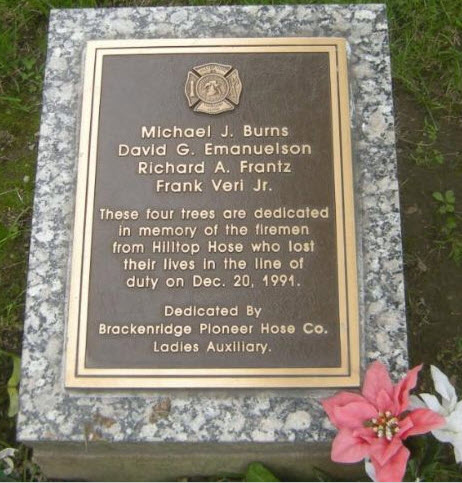Remembering Brackenridge 1991 Floor Collapse and LODD
By Christopher J. Naum, SFPE on Dec 21, 2010 with Comments 0
Remembering Brackenridge, Pennsylvania December 20, 1991: Four Firefighters Killed, Trapped by Floor Collapse
Four volunteer firefighters died when they were trapped by a partial floor collapse during a structure fire in Brackenridge, Pennsylvania, on the morning of December 20, 1991. All four were members of a mutual aid truck company that had responded to the early morning incident and were assigned to prevent fire extension from the basement to the ground floor of a 2-story building.
Although they were wearing full protective clothing and using self-contained breathing apparatus, it appears that they were overwhelmed by the severe fire conditions that erupted when a section of the ground floor collapsed into the basement. The collapse cut off their primary escape path, and the fire burned through their hose line, leaving them without protection from the flames.
SUMMARY OF KEY ISSUES
- Situation: Fire in enclosed room in basement. Unable to locate fire because of smoke. Smoke and heat increasing, but no visible fire.
- Structure: Appeared to be heavy concrete construction. Actually thin concrete floors supported by unprotected steel.
- Contents: Furniture refinishing business. Quantities of flammable finishes and solvents in basement.
- Exits: One entrance/ exit on each level; no alternate exits.
- Structural Collapse: Floor section collapsed between interior crew and their only exit. Fire overwhelmed crew.
- Rescue Attempts: Valiant rescue efforts proved unsuccessful. Unsure if missing members fell into basement or were trapped on ground floor.
- Incident Command: No formal command system or personnel accountability in place. Chief of first-due company in command of incident; Assistant Chiefs assigned to basement and ground floor.
- Information: No pre-fire plan and no detailed knowledge of occupancy. Clues of structural danger not recognized as fire conditions increased
- Communications: Radio system inadequate for current needs.
- Response: Independent volunteer companies. Mutual aid requested on arrival and additional companies called in succession.
- Weather: Extremely cold night, predawn hours. Problems with frozen hydrants.
- Water System: Weak supply. Extensive mutual aid and long relays needed to protect exposures.
The analysis of this incident provides several valuable lessons for the fire service. Unfortunately these are all revisited lessons, not new discoveries. These firefighters died in the line of duty, while conducting operations that appeared to be routine, and were unaware of the situation that was developing below them. They died in spite of the fact that they were experienced, they were operating with a standard approach to operational safety, and they were the object of repeated rescue attempts by highly capable comrades.
There are several factors that could have provided warning or changed the outcome of this situation. Like most accidents, this situation was the result of a number of problems that came together under the worst possible circumstances. Firefighting obviously involves inherent dangers that must be accepted by its practitioners. The important messages for the fire service are to identify risk factors in advance of an incident and to develop mechanisms to react appropriately when critical situations present themselves.
This situation bears distinct similarities to other incidents that have claimed the lives of several firefighters in the past. The lessons that must be derived from this incident are not a condemnation of the actions or judgment of anyone who was involved in the situation; they simply identify information that can help to prevent this type of accident from occurring in the future.
USFA Report; HERE
NFPA Summary; HERE
NFPA Report Order; HERE
Brackenridge Pioneer Hose Co. Memorial, Pennsylvania, HERE
Filed Under: BuildingsonFire • Fire Dynamics & Behavior • Tactical Operations
























